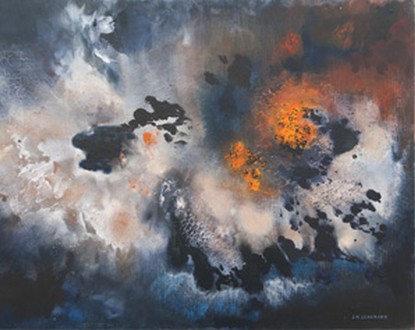The Jules Chéret Museum of Fine Arts presents an exhibition dedicated to Jules Henri Lengrand until November 2nd. This painter, born in 1907 in Marly les Valenciennes and deceased in 2001 in Lourmarin, Vaucluse, spanned the 20th century with its storms, wars, revolutions, and false hopes based on ‘isms,’ and his work, his oeuvre, and his art perfectly illustrate this.
Jules Henri Lengrand was, from 1934 to 1972, a professor at the School of Decorative Art in Nice and thus saw the emergence of the Villa Arson. This artist created the four frescoes once displayed in the salle des pas perdus of the Nice town hall: Nikaïa, Nice’s submission to the Count of Savoy, the annexation of Nice in 1792, and its attachment to the Empire of Napoleon III in 1860.
Jules Henri Lengrand is the author of many works in our department and particularly in Nice. The exhibition shows us this painter and part of his achievements. We are struck by the creation, the genesis, the big-bang, and the apocalypse. Everything is intertwined yet not mixed, which is important to emphasize.
The origin of the universe? A text, a biblical image? Almost. During the opening, the four rivers of the Garden of Eden were evoked, and through a magnificent metaphor, they became: colors flattering the sight, music flattering the hearing, words or poetry, and friendship. In 1967, well before the frescoes on the origin of the world and the apocalypse, Jules Henri Lengrand mentioned the conditions of artistic work: “…If nothing is done without faith and enthusiasm, nothing can be done.” This painter, perhaps because he was a professor of painting and drawing, is unclassifiable, belonging to all schools: abstract, figurative, cubist, impressionist…
A line nevertheless defines him: the divine in its essence is always present. “In a world where art is too often subject to the imperatives of materiality, it would be desirable for us to restore to form its power of suggestion and its content of thought.” The artist spoke thus during a conference in 1967. Jules Henri Lengrand was a precursor in the 20th century, enslaved by Marxist and capitalist materialisms, a precursor because he opened the doors to other choices, other options.
He embraced Malraux’s phrase: “The 21st century will be spiritual or will not be.” This exhibition will allow you to discover the multiple facets of this artist: paintings, stained glass, drawings, images of the animal world. Everything in him is ether and power, strong and light. These oxymorons here take their noblest meaning.
The Jules Chéret Museum was the ideal setting to showcase the paintings of Jules Henri Lengrand, an artist who came from the north and its mists, seduced by the southern light where he settled, ending his life in Lourmarin in Provence.
Thierry Jan


